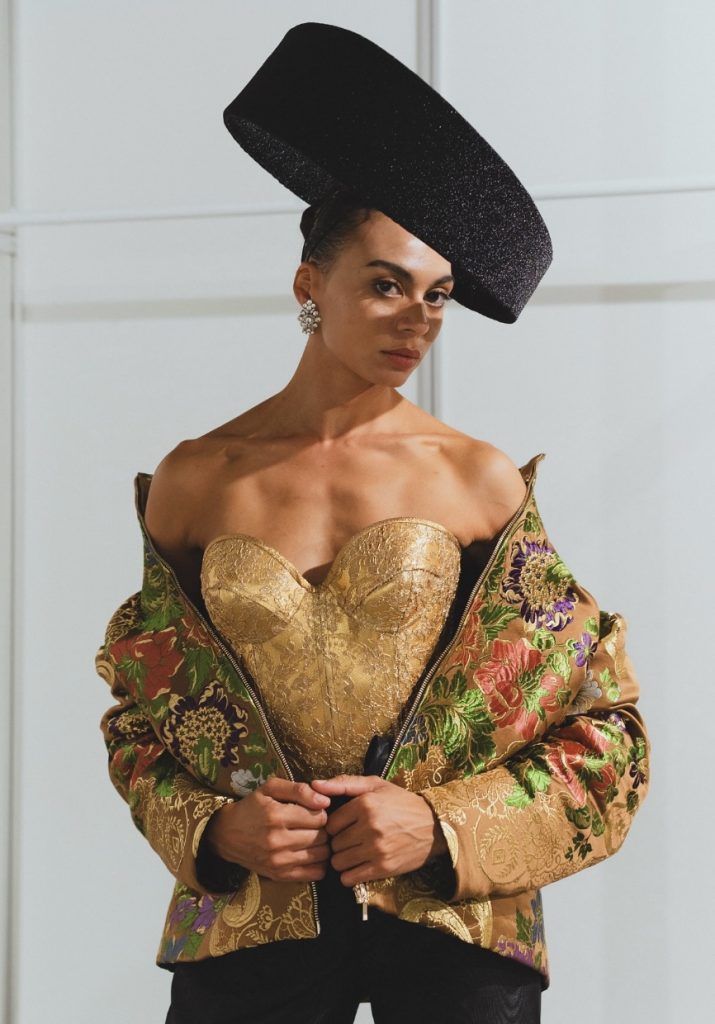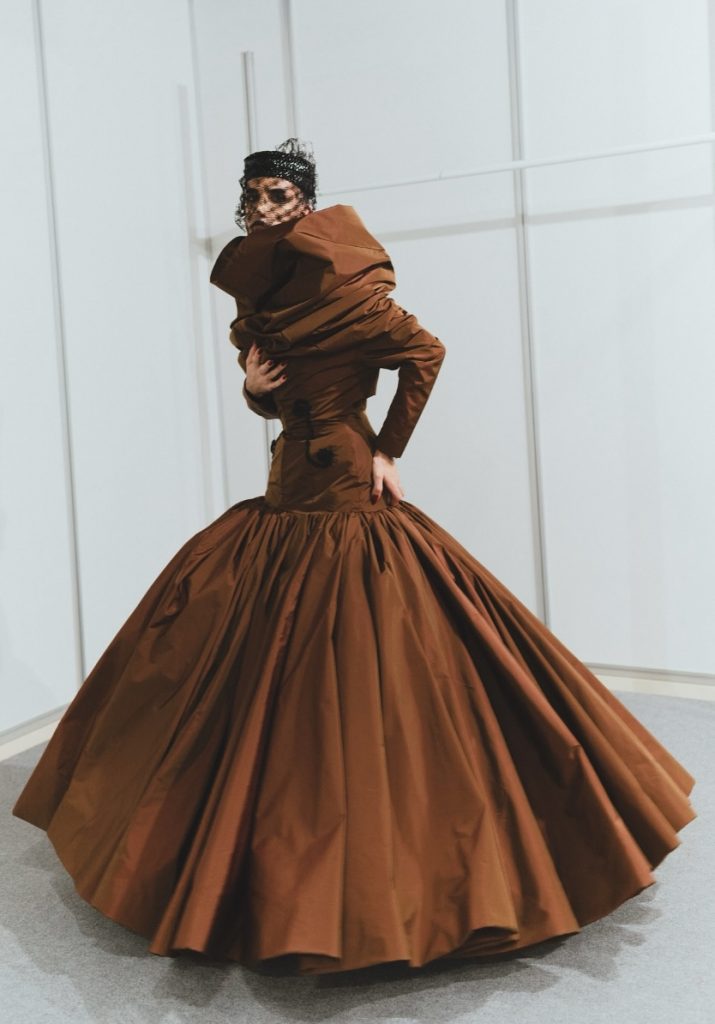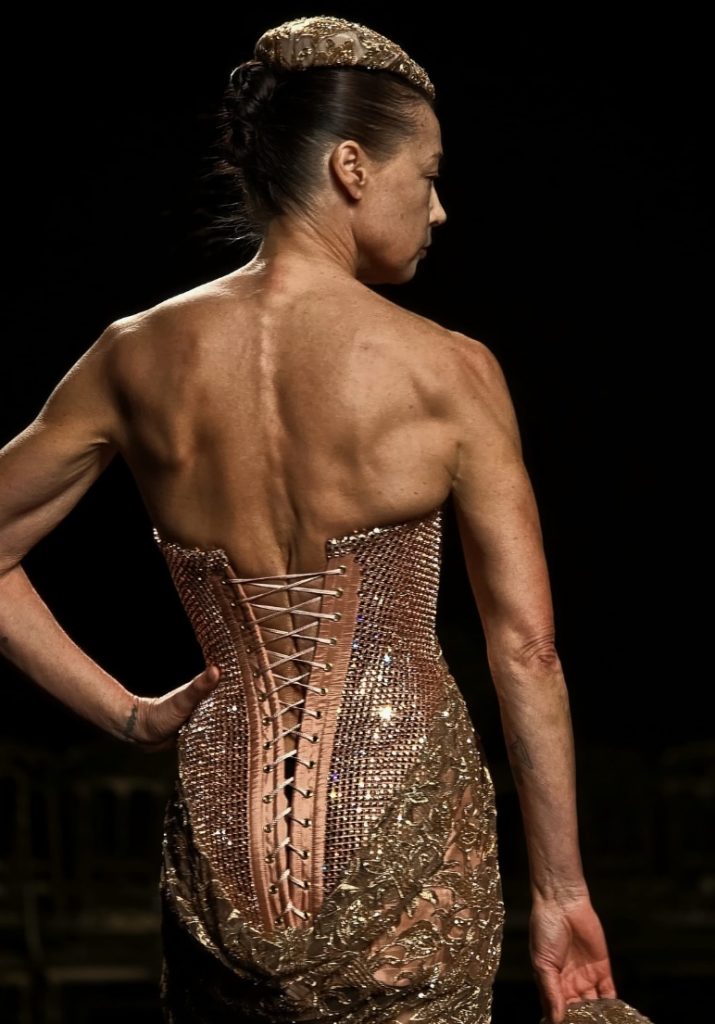

GUILLERMO DÉCIMO: AN IN-DEPTH INTERVIEW
Guillermo Décimo stands as one of the most captivating new voices in contemporary Spanish fashion. With a vision rooted in craftsmanship, theatricality, and timeless beauty, his work bridges the delicate line between couture tradition and artistic expression. From his beginnings at EASD Burgos to his presence on international runways in New York, Milan, and London, Décimo’s creations speak of patience, precision, and poetry—each stitch carrying the weight of time and the intimacy of the handmade. In this conversation, the designer reflects on his origins, his relationship with time and craft, and the philosophy that sustains his brand, GX, in a world ruled by immediacy.

Álvaro Ramos: To start, a complicated but straightforward question: Who is Guillermo Décimo as a designer and as a brand?
Guillermo Décimo: GX is a brand committed to eternal beauty, quality, a focus on tradition and craftsmanship, but all without losing sight of the current situation in every aspect. As a designer, GX is an artist who enjoys creating his work and doesn’t overthink everything else.
AR: Your journey began at EASD Burgos, where you graduated from the Higher Artistic Education in Fashion Design; but my question is more related to the pride you feel in being from there. What has it been like to build a career like yours, coming from the «periphery» and fitting in with the elitist world of fashion? Do you feel it’s a class statement to always remember where you come from, distancing yourself from all those designers who refuse to thank the academic institution where they started?
GX: It’s been building itself. For as long as I can remember, I’ve been working on it, often without even realizing it, but enjoying what I was doing. And that’s always been the key: experiencing it as something for myself, and not thinking so much about the rest. For me, it’s wonderful to say where I’m from. I say it naturally and without giving it too much importance, just the right amount of importance it deserves, since being from a specific place, as an artist and as a person, influences us.
AR: You’ve trained with big names in fashion like Ulises Mérida, Ana Locking, and Javier Martín Galán at the Balenciaga Museum. What fundamental lessons have you learned from each of these experiences?
GX: Well, everything, just imagine… When it comes to sewing and the world of fashion, each brand, designer, and seamstress has their own enriching methods and ways of working, and you learn a lot from all of them if you’re observant. And obviously, on a personal level, it’s wonderful everything you can share with people who share your same motivations and interests.
AR: There’s a strong sense of theatricality and artistry in your work. Where does this need to give fashion an almost theatrical dimension come from?
GX: I suppose it comes from what one sees and observes as a child and throughout one’s life. And also because I’m the way I am, and that’s it. Everyone is inspired by certain things, and in my case, it’s been those baroque and more ornate worlds.

AR: You’re a designer, pattern maker, dressmaker, illustrator, and artisan, and you make each garment from start to finish with your own hands. What advantages and challenges do you find in taking on the entire creative and technical process?
GX: As an artist, I need to know how to make something from start to finish so I can ensure that everything turns out the way I want it. It’s also very satisfying to create the product you imagine yourself. I think that’s the essence and also the complexity.
AR: After your time at EGO at Mercedes-Benz Fashion Week Madrid in previous editions, you’ve made the international leap to major runways such as New York, Milan, and London, alongside Sprayground. What differences have you noticed between these fashion weeks, and what lessons have they taught you?
GX: They’re completely different projects, and each one focuses on one thing. They also have different ways of designing, of creating a garment, a concept to showcase… They have nothing in common, but instead, they all come together in garments that originate from me.
AR: In a world where fast fashion dominates much of the market, your approach is one of timelessness, craftsmanship, and authenticity. Do you think there’s a real shift in consumers in that direction?
GX: Not among the general public, not at all, and that’s a shame. Another thing is the profile of the fashion consumer who knows and appreciates, knows how to shop, understands everything behind it…
AR: What role does illustration play in your creative process? Do you usually start with drawing to build a collection, or is it more of a parallel tool?
GX: I always make a quick sketch of the ideas that come to me, to visualize them and see if I like them or not. From there, from that pencil sketch, I move on to the fabric piece, which often evolves throughout its creation, differing from the initial sketch.
AR: For you, what is the future of fashion? Where do you think the industry is headed in the coming years, and where do you want to position your brand in that landscape?
GX: Honestly, these are questions I don’t ask myself too much or want to think about. I don’t feel like getting overwhelmed with long-term ideas for the future. I prefer to be very aware of the present, enjoy it to the fullest, and give my all in the moment. The rest will come later.
AR: After all these years in the industry, how does it feel to win an award like the Mercedes-Benz Fashion Talent Award?
GX: It’s an immense joy. It was a thorn in my side, and finally achieving it has made me incredibly excited. Also, with this very special collection, I’ve given everything I have to complete and make it perfect.
AR: The title of your latest collection, “In Tempo”, comes from musical language and alludes to interpreting a work exactly as it was composed, in its perfect measure. Why did you choose this metaphor to talk about sewing?
GX: It’s something that emerged one day, out of nowhere, amidst thousands of thoughts and endless stitches. Classical music and its interpretation are closely related to sewing. Both are disciplines in the art world in which the constant pursuit of perfection becomes vital.

AR: You talk about how your creative universe combines tradition, craftsmanship, and timeless beauty. How do you balance these three concepts without losing freshness and connection to the present?
GX: By being true to what I love and what excites me. There comes a time in the creative process when, after much looking, observing, and investigating, you have to let go of everything to focus on what you believe in. Be true to yourself. In my case, when this happens, I manage to connect with the audience.
AR: In your words, some garments are preserved intact, while others transform over time, yet they always maintain their essence. How do you incorporate this duality—intact and worn—into the collection’s designs?
GX: I like to play with the idea of creating pieces that look 50, or 100 years old… I’ve always been drawn to the slight wear and tear on garments, torn or frayed fabrics… and I recreate precisely these types of effects in my garments, giving them something extra, a detail that at first might seem to make them ugly, but ultimately adds texture, life, and another dimension.
AR: You talk about the value of time, of not rushing, of not creating without measure. Do you think this philosophy is also a form of resistance to fast fashion and the immediacy of the market?
GX: It’s a form of resistance to survive in the world and live our lives informed about it. Time already moves too fast for us to accelerate it any further.
AR: Timelessness is one of the pillars of your brand. How do you make a collection that dialogues with the past and reflects on time simultaneously contemporary?
GX: By observing a lot, seeing a lot of fashion, especially that of the past. That fashion that dictated eras, and not so much the current one, which changes from one week to the next with micro-trends (something I hate). I think it’s very important to know, even visually, to have references and role models, but to adapt them to your own style.
AR: What techniques or materials were key to shaping «In Tempo» and sustaining that idea of sewing as a work of art?
GX: The key is time itself. Each piece requires hours and hours of internal work, reinforcements, interfacing, fillings, hemming, linings, closures, and hidden zippers… That’s the key to sewing: creating from the inside out, thinking about what the design will be like and what it needs so that, once worn, that internal complexity is forgotten but allows it to shine with its own light.
AR: The collection exudes a deep respect for tradition, but also a renewed approach that reaffirms your creative universe. Where do you draw the line between preserving the classic and innovating with your personal touch?
GX: Specifically, this collection traveled to that classic essence and aesthetic of haute couture from the 1950s and 1960s, but suddenly certain details, cuts, colors, or an unexpected material… It’s small details that bring that contemporaneity. Likewise, by not following trends and pursuing a classic aesthetic, it’s always easier to ensure that the project doesn’t die in subsequent seasons.
AR: Finally, what dreams do you still have to fulfill as a creator, and where would you like to see Guillermo Décimo’s universe travel?
GX: I want to enjoy the process. To continue creating and showing the public what I do, so they can enjoy it with me. From there, when and how this happens, I’m not too worried about.
Words: @alraco43
